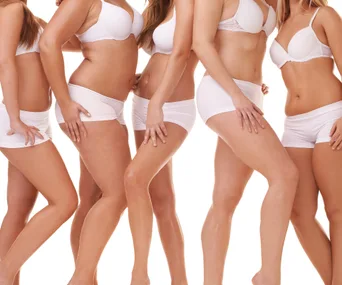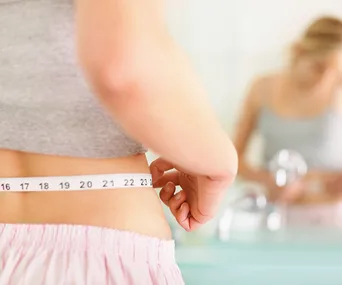Fat – we all have it. Some have a little, some have a lot – most of us don’t know much about it. So here are 10 fat facts to inform and amaze you – and yes, help you get rid of it.
1. We need some fat to be healthy
“The average woman carries about 20 to 25kg of fat,” says Dr Jarrod Meerkin from Sydney’s MeasureUp body composition scanning service.
“That fat provides back-up energy when blood sugar runs out, it insulates the skin from cold and heat and helps transport nutrients across cell membranes.
It also provides the building blocks for hormones.”
2. Fat is part of your immune system…
… but even scientists didn’t know that until earlier this year.
It seems the subcutaneous fat that lies just under the skin’s surface actively protects us against invaders. Within hours of exposing an area of skin to Staphylococcus aureus bacteria in a lab, fat cells around the site were producing anti-microbial chemicals to kill the bug.
The moral of this story: low body fat is healthy – but very low body fat is not better. “A normal body fat percentage for women is 21 to 33 per cent, depending on age,” says Dr Meerkin.
3. Throw away your scales and get some string
Normal scales don’t reveal your body fat level, and even those that do show your percentage don’t tell the whole story because what matters for health is not just what percentage of fat you have but where you carry it.
Fat around the middle is more dangerous to health than fat around your hips and thighs. One simple way to measure if you have too much tummy fat has been created by British doctor Margaret Ashwell. Cut a piece of string the same length as your height, fold it in half and wrap it around your waist.
If the ends don’t meet, you’re carrying too much fat here. “You need to keep your waist to less than half your height if you want to stay healthy,” she says.
4. If you’ve only got a little bit of extra fat round your hips, relax
While it’s well-known that excess kilos increase your risk of developing health problems like heart disease or diabetes, recently scientists have learned something strange: people carrying a few extra kilos are less likely to die of these problems than the underweight.
The University of Queensland’s Dr Carl Lavie, author of The Obesity Paradox, was one of the fi rst doctors to spot this. “Very thin people often have the worst prognosis – especially if they are unfit,” he says.
“These people have low muscle and poor muscular strength, which is an important prognostic sign for survival of serious illness. Extra kilos can provide a metabolic reserve.”
Note: When you tip from overweight into obese, this protection stops. Also, this does not mean everyone should become overweight.
Dr Lavie says thinner people should not actively gain weight to get the boost.
Instead they should improve fitness and build more muscle to strengthen their system.
5. You don’t have to shed weight to lose weight
The so-called ‘apple’ body shape is caused by visceral fat – a type of body fat which accumulates within the abdomen and around internal organs such as the liver and pancreas – a major risk factor for Type 2 diabetes, heart problems and liver disease.
Exercise reduces this harmful visceral fat, even if you don’t seem to drop kilos. In a recent Australian study, 45-minute workouts of any kind three times a week did the trick.
6. When you do lose weight, you actually breathe it out
Believe it or not, until last year we didn’t have a clue what happened to any fat lost through diet or exercise. But then researchers at the University of New South Wales discovered we actually breathe most of it out with the carbon dioxide we exhale.
Sadly, this does not mean breathing faster triggers weight loss – unless you’re doing it because you’re sprinting!
7. Liposuction can make you FATTER
Two studies have recently discovered that you can’t cheat your fat cells. When women had liposuction – on their thighs in one trial and on their tummies in the other – within a year an equivalent amount of the fat they’d had sucked out came back.
And the fat came back as dangerous visceral fat that collects deep in the abdomen. To avoid this you have to exercise.
Brazilian researchers found that women who did a combination of cardio and weight training three times a week retained their new shape with no fat regain.
8. There is one type of fat you do want more of
… and you make it by turning on the airconditioning. It’s called brown fat and it collects around the neck, shoulders and chest. As babies we use this type of fat to keep us warm and until recently it was thought that we lost it as adults, but now scientists have discovered most of us still possess it.
We just need to reawaken it – and one way is by feeling cold.
In studies at Sydney’s Garvan Institute of Medical Research, men who spent a month in a 19°C room raised their levels of brown fat by 30 to 40 per cent. So why do you want brown fat? It burns kilojoules and can help you manage your weight.
9. Fat cells communicate with other parts of our body
And the messages they send aren’t good ones.
In 2013 a team in Texas found that fat cells actually make our immune system believe that it’s under attack. The immune system then mounts an inflammatory response to stop this which causes chronic inflammation in the system.
“Chronic infl ammation is very destructive in nature and the driver behind a multitude of diseases such as cardiovascular disease, cancer, diabetes and autoimmune disease,” says Kate Johnston, naturopath and nutritionist at Sydney’s Kore Well-Being.
Losing weight obviously helps fi ght this, but using turmeric (in cooking or as a supplement) and taking a good quality fi sh oil daily can be beneficial. “Both help to reduce inflammation by inhibiting the COX enzyme that sparks the inflammatory cascade,” says Johnston.
10. Red wine helps you burn fat
A chemical in the grapes called ellagic acid aids fat-burning and slows down how fast existing fat cells form or grow, shows a US study.
This doesn’t mean you can go on a wine diet to get thin, though. “We didn’t fi nd that these compounds would improve body weight,” says study author Neil Shay.
Instead the fat burned was in the liver, which the researchers say may help improve liver function.
To lose fat you can actually see and feel, try eating dairy. In another US study, people who consumed 1100mg of calcium from dairy daily (about three 250ml glasses of milk) as part of a kilojoule-controlled plan lost 1.5kg more body fat than those who didn’t.




